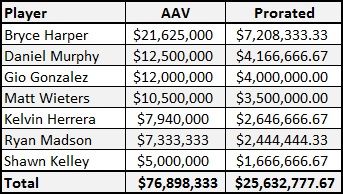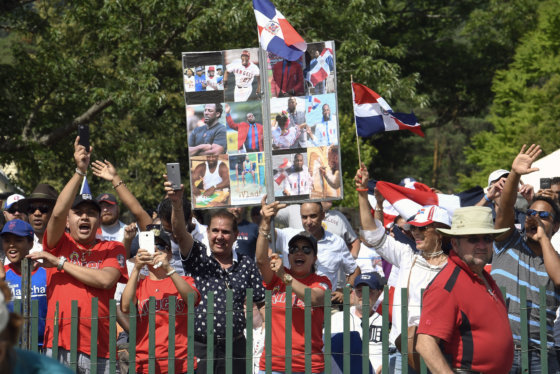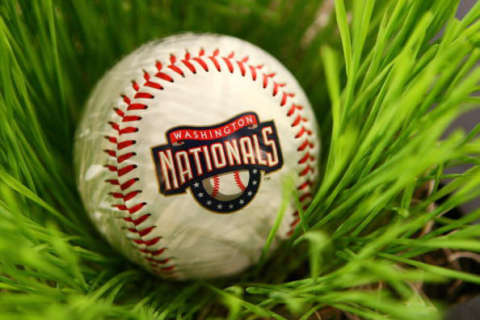WASHINGTON — Whether you think the Washington Nationals have what it takes to try to compete in 2018, the decision of what to do before Tuesday’s 4 p.m. trade deadline is more complicated than a binary judgment of addition or subtraction.
The reason to sell, in such a situation, is twofold. If you have expiring free agent contracts, you want to get the most value out of them. So if you know you’re not going to compete, conventional wisdom dictates you should trade them for younger players with more years of team control. This, in turn, gives you a chance to rebuild for a (hopefully) brighter tomorrow.
But MLB’s relatively new, Byzantine luxury tax rules have left the Nationals in a tricky spot in regards to both their short- and long-term plans, one which will require a delicate juggling act to navigate between now and the end of the season. Their insistence on waiting until now to decide what to do about all of this has only complicated matters further, making the question of “Buy or sell?” far more intricate than it appears on the surface.
According to Cot’s Contracts, the Nationals’ current payroll projection is $208,548,348. It’s worth listing it out to the dollar, because every cent matters right now. The luxury tax threshold for 2018 is $197 million, putting the Nats nearly $11.6 million over that mark. The tax rules dictate that for each consecutive season a team finishes over the threshold, they’ll pay an escalating tax (20 percent Year 1, 30 percent Year 2, 50 percent each year after that) on the extra money they spend.
Since Washington broke the threshold last year, if they finish the season over again, they’ll be on the hook for 30 percent of whatever excess they spend. With the big contracts already on the books, the Nats already have more than $100 million counting toward next year’s tax threshold (which goes up to $206 million). If they plan to re-sign Bryce Harper, there’s a good chance they’ll go over for third consecutive year and hit that 50 percent mark, making a potential deal that much pricier. Whether or not Harper is a National beyond this year, though, there is a real incentive to find a way back below $197 million this season, which would reset the luxury penalty to zero. That would save the team money no matter what happens with Harper.
In practice, though, that’s not so easy, especially since the Nats have waited this long to make a decision on their direction.
Accomplishing this requires clearing that aforementioned $11.6 million in prorated contracts, which are essentially one third of their full value at this point of the season (more than $34.5 million in total value). Trading Harper, for instance, would only clear a shade under $6.5 million (one third of $21.625 million), and would barely get them halfway there. Daniel Murphy ($12.5 million AAV, $17.5 million this year), Gio Gonzalez ($12 million), Matt Wieters ($10.5 million), Kelvin Herrera ($7.94 million) and Ryan Madson ($7.3 million AAV, $7.7 million this year) are the other large, expiring contracts the team might be able to offload, but doing so would compromise their ability to get much in return prospect-wise, if they’re asking other teams to take on salary. Outside of Herrera and Gonzalez, those are largely dead-weight contracts that other clubs won’t be jumping to absorb, much less give up top talent for.

(A quick note: the deferral money in several of the Nationals’ contracts makes them hard to be certain about without seeing the exact breakdowns. Based on conversations with those inside baseball, the Cot’s numbers are close, though some deferred money may give the Nats a little more room against the luxury tax, particularly on Stephen Strasburg’s deal).
Also the Cot’s numbers, while valuable for these things, are still an estimation. For whatever reason, they don’t include the $1 million deal for Mark Reynolds, nor the $2 million for Jeremy Hellickson. Those would bump the overall payroll an additional $3 million that would need to be cleared, making the calculus even more daunting.
So unless the Nats want to completely strip the team for parts, accepting that the prospect return might be minimal in order to dump salary, they might not be well-advised to sell at all. While the alternative — buying — may seem preposterous given their level of play, consider the bizarre, flat landscape of the National League, particularly the NL East.
Name the best rotation in the National League. The Cubs have plenty of big names, and just added Cole Hamels, but they’ve got exactly one starter with an ERA under 4.00. The Dodgers have the best rotation ERA (3.30), but both Clayton Kershaw and Rich Hill have battled through multiple DL stints. Does a Ross Stripling-Alex Wood-Kenta Maeda-Walker Buehler playoff rotation strike fear in your heart? Arizona falls off pretty quickly after Zack Greinke and Patrick Corbin. Aaron Nola’s been awesome, but the rest of Philly’s starters have been up and down.
The point is that the answer isn’t obvious and that, as a result, there is no clear favorite among the Senior Circuit clubs heading down the stretch toward the playoffs. It’s easy to look at the Nats at 52-53 and say they should punt in 2018. But with a league (and a division — more on that later) so wide open, there’s a good case to be made that Washington should patch its holes the best it can and go for it. The 2006 Dodgers were 47-55 in late July and made the playoffs with 88 wins, a number which may well be enough to win the NL East this year. Besides, any year you have a chance to make the playoffs with Max Scherzer, Bryce Harper and a (hopefully) healthy Stephen Strasburg is one you should not casually throw away.
Now, the Wild Card isn’t going to happen. There are too many good teams ahead of Washington for all of them to falter. But the division, despite everything, is still there for the taking. With 57 games to play, the Nats are six games behind the Phillies, 4.5 back of the Braves. That means, essentially, playing just one game better every 10 the rest of the way. Given the quality of their opponents, this is not an unreasonable ask.
Neither Philadelphia nor Atlanta have the kind of dominant rotation or experience that would lead anyone to believe they’re ready to put the pack behind them. Likewise, neither team made the kind of impact addition (yet, at least) to address their most pressing needs heading into the dog days. The Phillies’ and Braves’ play has done nothing to indicate that they’re ready to run away with the division, either.
Philadelphia is 14-10 in July overall, but has lost seven of 12, including series losses to both the Marlins and Reds, the latter of whom just took three-of-four from Philly this weekend. The Braves, meanwhile, have been dreadful. They salvaged the series finale with the Dodgers, but are just 8-13 in July. The Nats have seven more games against Atlanta and nine more against Philly to gain ground. Plus, the two division rivals play each other seven times in the season’s final week-and-a-half, while seven of the Nats’ final 10 come against the Mets and Marlins. The Nats have plenty of winnable games, with the eighth-easiest schedule in baseball the rest of the way (Philly has the seventh-easiest, Atlanta the 13th).
So, what, buy? The Nats have been smart to hold their few high-end prospect chips for the future, but there is help out there at a more reasonable cost right now. The most obvious available upgrade is at catcher, though it doesn’t seem worth the price to pay for Miami’s J.T. Realmuto. With Wilson Ramos set to return to action, acquiring him from Tampa (for a lower cost) could provide a better bat than Wieters, a familiar signal-caller for the pitching staff, and potentially an emotional lift for a team that has too often seemed uninspired and rudderless this season. It would be a signal from the front office that it still believes this year is salvageable.
There are some decent starting pitching options out there as well, though nothing as impactful as a healthy Stephen Strasburg returning to the rotation. His health remains a question mark, but this team likely isn’t heading anywhere in this, or any other, year without him pitching behind Scherzer in the rotation. There are some intriguing back-end starters (like Mike Fiers) who wouldn’t cost much, and at least the club is running with veteran Tommy Milone (5 IP, 3 ER, 0 BB, 6 K in Thursday’s 10-3 win) in the meantime instead of throwing rookies in the fire.
Whether or not you believe Bryce Harper is staying in Washington long-term, punting this season can’t help the cause. If the Nats find a way to salvage it, though, things might change for the better.
After a miserable June that saw him slash .188/.333/.341, Harper himself has looked quietly better since the break, slashing .286/.417/.536 after reaching base three times Sunday. Daniel Murphy has hit .324 in July with more walks (9) than strikeouts (7). While Ryan Zimmerman may be beyond repair, getting the now healthy Victor Robles to the big leagues and adding Ramos to the lineup could well provide a spark for a team that has seemingly sat in limbo for weeks.
Unless you can shrewdly and craftily blow the thing all the way up to get under the tax threshold, the best option for the Nats may well be to try to patch things up around the fringes, take one last shot with Harper definitely in uniform, and worry about next year next year.






